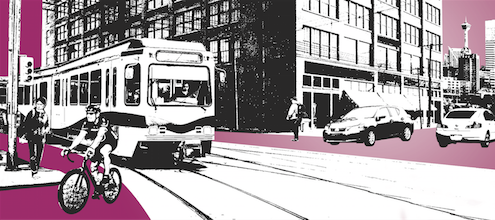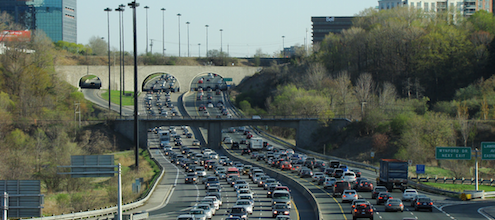
Holding your breath for cleaner air: congestion pricing and air pollution
Last November, we released a report on how pricing congestion—charging drivers to use roads to ensure faster and more reliable commutes—can help solve crippling congestion in Canadian cities. Governments can design congestion pricing systems according to different objectives; we argued that the number one priority should be to reduce congestion in order to use road space more efficiently and generate significant economic benefits. But curtailing congestion can also bring about important health benefits. Here I explore how reducing congestion and improving air quality can be complementary objectives, and how reducing gridlock can mean cleaner air for everyone.
The links between road congestion and air pollution are real in Canadian cities
Tailpipe emissions from vehicles are a significant source air pollution. When emitted in large concentrations, these pollutants form smog and ground-level ozone; and because vehicles tend to emit higher levels of emissions in stop-and-go traffic, road congestion is a big contributor to local air pollution in our cities. Roughly one-third of Canadians live in areas near highways or major urban roads, exposing a large portion of our communities to the ill effects of vehicle emissions and congestion.
The health impacts from air pollution are numerous and varied. Air pollution from vehicles is related to higher risks of asthma, high blood pressure, cardiovascular disease, diabetes, cancer, and reproductive problems. For infants and kids, long-term exposure can result in impaired lung development, low birth weight, preterm pregnancy, childhood leukemia, and premature deaths. Even cyclists could have an increased health risk from air pollution. When monetized, the economic cost of these health impacts are an estimated $5–$9 billion annually.
Air pollution from traffic can be avoided; reducing it can generate significant benefits
The links between tailpipe emissions, traffic, and poorer human health are well established. But the good news is that a sizable portion of air pollution can be avoided by reducing congestion. We argue one of best solutions for reducing congestion is to implement some form of congestion pricing.
Real-world outcomes of congestion pricing are a useful reminder that reducing air pollution can generate important health benefits. Improving air quality was the primary objective of the congestion pricing system in Milan, which charges drivers based on the level of emissions from their car. Researchers estimate that the environmental benefit in Milan from cleaner air is roughly $3 billion each year. In Stockholm, one study found that the annual average concentration of nitrogen dioxide—a contributor to smog—fell by up to 12% along the streets with the most dense traffic volumes after the introduction of congestion pricing. Concentrations of particulate matter (PM10) were reduced by up to 7%. Gains in air quality have also been recognised from congestion charging systems in London and Singapore.
The other double dividend: faster commutes and cleaner air
Although vehicles are but one of several sources of air pollution, reducing road congestion can be a clear-cut way to make meaningful improvements to air quality: fewer traffic jams means less time idling, which means fewer emissions in the air. The Ecofiscal Commission has made the case that congestion pricing is the best way to get us there—smoothing traffic flows can make our trips faster and more reliable, while deferring the (costly) need for bigger and wider roads. But as the conversation of implementing congestion pricing in Canada moves forward (I’m looking at you, Vancouver and Toronto), let’s not forget about the double dividend from congestion pricing: faster travel AND cleaner air.




Comments are closed.